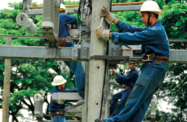Hopes of a path towards energy independence in the Philippines are gathering pace thanks to encouraging steps forward at the Malolos-1 onshore well in Cebu. Australian oil firm Gas2Grid said in July it is in the process of applying to the Department of Energy (DoE) to increase production for a full appraisal of the field.
Early tests show that the well is capable of producing 200 barrels of crude daily, a production level maintained for short periods, according to the explorer. Thus far, estimates put total reserves at 20.4m barrels.
But while the country’s offshore reserves are most often cited as the highest-potential energy reserves available, recent offshore developments have been less promising. London-listed Dragon Oil confirmed in July that Baragatan-1 offshore well in the Palawan basin, in which it has a 40% stake, was incapable of producing commercial hydrocarbons.
Worth pursuing
Earlier testing at Malolos had shown that the field’s lower and upper oil-bearing sandstone were both able to produce oil individually, but the well’s oil production rate had been lower than officials had hoped. The company announced later in June that measures to repair the pipeline had significantly improved the field’s sustained oil flow rate.
Although work on the field has been suspended while the company waits for approval from the DoE, Gas2Grid’s managing director, Dennis Morton, told local media in July that he expects the field will produce oil at commercial rates. “This is a resource well worth pursuing,” he said.
This is the first positive development since the DoE confirmed in January that Gas2Grid had found oil in the Malolos-1 fields. At the time, the firm estimated initial costs of the development to be between $500,000 and $1m.
Fossil fuel dependency
Despite moves to develop and enhance renewable energy, the Philippines remains dependent on fossil fuels, with oil and mineral fuels comprising 22% of imports between January and September 2013 and representing the third-largest category after raw materials and capital goods.
Oil consumption increased 5.5% year-on-year to reach 298,000 bpd in 2013, according to the BP Statistical Review of World Energy 2014. However, a lack of new production has led to decades of decline in domestic output, which stood at 8.57m barrels in 1979 but fell to less than 2m by 2012.
New activity
The DoE reported that 1.44m barrels of oil were produced between January and September 2013, compared to 1.64m barrels in all of 2012, while five exploratory wells were drilled during the year, including sites at Malampaya, drilled by Shell Philippines Exploration, and new wells at the Galoc offshore oilfield. Onshore developments included Malolos-1, as well as Duhat-2 in Onshore Leyte, which is estimated to contain 88m barrels of oil – although safety concerns led Australia’s Otto Energy to abandon its exploration efforts in 2013.
New exploration activities have been high on the government’s priority list. The DoE reported in its 2013 Energy Sector Achievement Report that the country’s 16 sedimentary basins have a combined potential of 4.77bn barrels of fuel oil equivalent, or 689.8m tonnes of energy of oil and gas reserves.
In May, it launched a tender for exploration rights in 11 oil and gas blocks, with most of the blocks located near the Philippines' main island of Luzon while one lies in a disputed area of the South China Sea. The DoE estimates that the area 7 block – located near Palawan – holds a resource potential of 165m barrels of crude and 3.5 trn cu feet of natural gas.
The Galoc field, located off the northeast coast of Palawan, remains the most productive reserve, with Otto Energy reporting the field produced 1.8m barrels in 2013. Production has been supplemented over the years by output from the Nido, Matinloc, and North Matinloc fields, while Nido Petroleum announced in March that its revised estimate of proved developed reserves in Galoc had increased by 1.57m barrels, to 11m barrels in total.
Follow Oxford Business Group on Facebook, Google+ and Twitter for all the latest Economic News Updates. Or register to receive updates via email.

